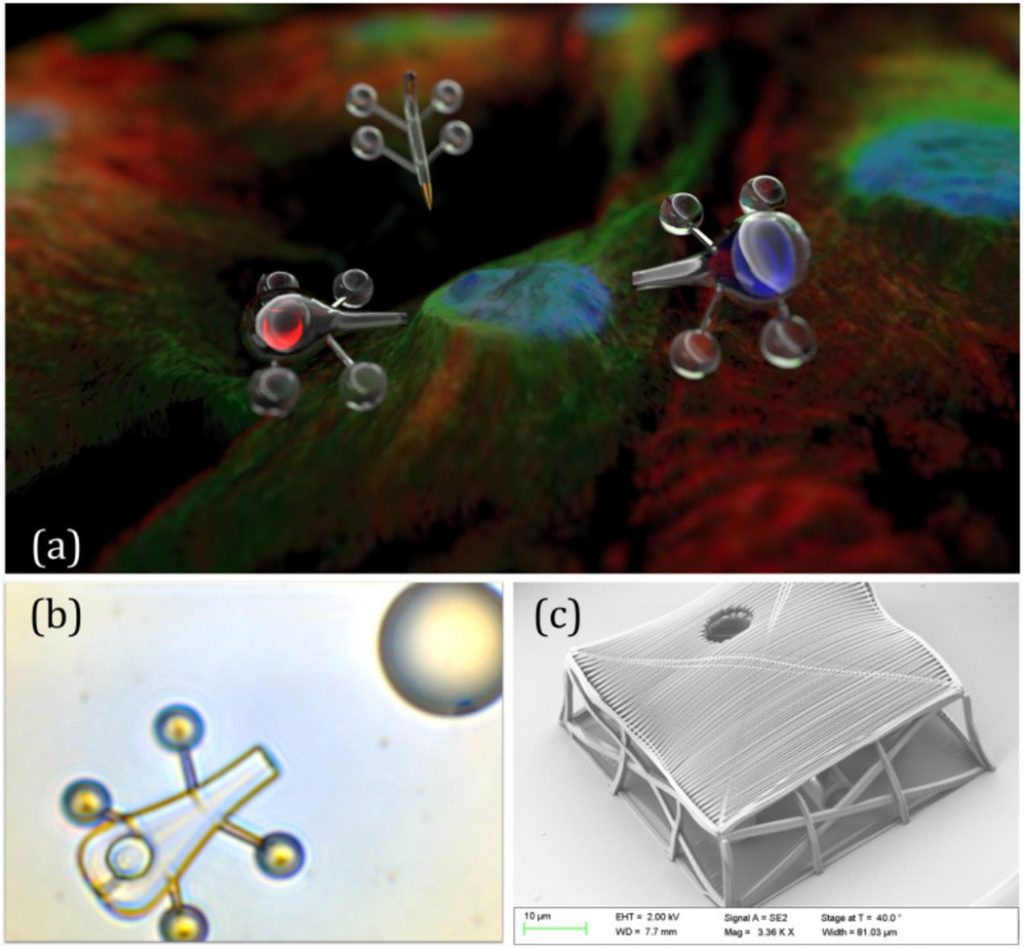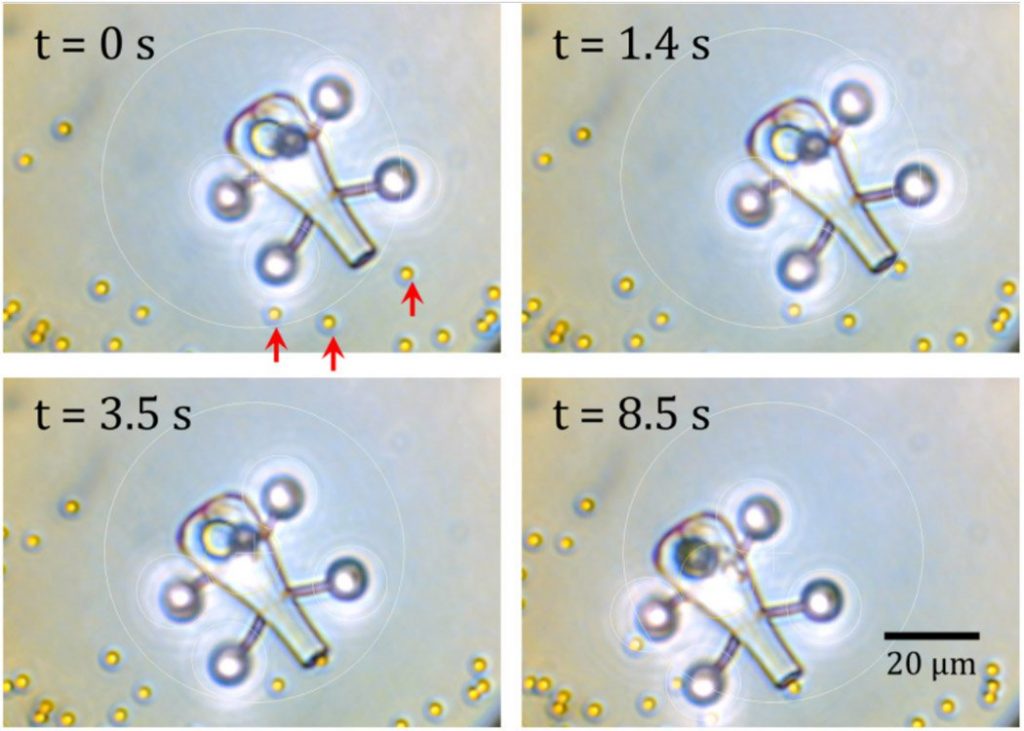 Light is an important part of 3D printing; in almost every version of the technology, light is what solidifies the material into layers to create an object. It can also be used in 4D printing as well, to generate movement. In a study entitled “Two-photon polymerization for 3D printing light-controlled microrobots,” a group of researchers use light to control microscopic 3D printed robots.
Light is an important part of 3D printing; in almost every version of the technology, light is what solidifies the material into layers to create an object. It can also be used in 4D printing as well, to generate movement. In a study entitled “Two-photon polymerization for 3D printing light-controlled microrobots,” a group of researchers use light to control microscopic 3D printed robots.
As the researchers explain, light can also be used to generate effects such as heat. In microfluidics, local heating is generated by using metal surfaces and metallic nanoparticles. This has enabled valve action, flow control and mixing. It can also operate as a catalyst for chemical reactions and has been used in cancer therapy. There is a limitation when using metal layers in microfluidic devices, however – they are usually fixed to a certain region while the motion and position of nanoparticles are difficult to control.
In the study, the researchers integrated metallic structures into a new type of light-driven microbot. They used two-photon polymerization to 3D print nanoscale robots with features such as hollow interiors for material transport, as well as a syringe action that allows the microrobots to load and unload cargo.

(a) An artist’s rendition of a multitude of light-driven micro-robots working together to probe a cell. (b) A hollow microrobot, designed for material transport, interacting with an oil droplet. (c) Scanning electron microscope image of the hollow microrobot. A mask is fabricated on top of the structure to secure exposure of only certain regions by metal-vapor deposition.
“The photoresist that we use in the fabrication of these light robots is practically transparent to the trapping beam wavelength and thus generates very little heat,” the researchers explain. “Metals are efficient energy-to-heat converters of light, so to enhance laser-induced heat generation in the polymerized light robots, we embedded a thin metallic layer inside each of them using vapor deposition. For this purpose, we deposited a titanium adhesion layer and a gold layer (of 1 and 5nm thickness, respectively) as a circular disk inside the body of each light robot.”
Once the microbots are introduced into a cytometry cuvette, they can be individually maneuvered using four counter-propagating beams that trap each of the spherical handles. An additional beam is used for controlled heating of the internal metallic layer. Laser heating forms a microbubble around which strong convection currents are generated. The convection currents can draw tiny silica beads into the structure.
“By combining convection currents with optical manipulation, each microrobot is made capable of picking up cargo at different locations,” the researchers continue. “The hydrodynamic effect that is used to move particles can be quite strong and, in contrast to optical trapping and manipulation, does not rely on the refractive-index contrast.”
Those silica beads, or other cargo, can then be released by moving the heating beam across the body of the microtool. According to the researchers, the microbots have a number of potential applications. They could be used for drug delivery in single-cell experiments, or to provide physical and chemical stimuli to biological samples.
“This control is not limited to a single robot and could potentially be extended to a large handful using advanced software (i.e., swarm robotics), thereby enabling microrobots to mutually coordinate to unveil new ways of interacting, probing, and acquiring information (e.g., for 3D microbiology),” the researchers conclude. “Ultimately, we forecast that light robotics will lead to completely new and disruptive schemes for real-time 3D interactions with the microscopic world. In our future work we will be investigating a range of applications for light robotics, particularly those relating to nanobiophotonics.”
Discuss this and other 3D printing topics at 3DPrintBoard.com or share your thoughts below.
Subscribe to Our Email Newsletter
Stay up-to-date on all the latest news from the 3D printing industry and receive information and offers from third party vendors.
Print Services
Upload your 3D Models and get them printed quickly and efficiently.
You May Also Like
Reinventing Reindustrialization: Why NAVWAR Project Manager Spencer Koroly Invented a Made-in-America 3D Printer
It has become virtually impossible to regularly follow additive manufacturing (AM) industry news and not stumble across the term “defense industrial base” (DIB), a concept encompassing all the many diverse...
Inside The Barnes Global Advisors’ Vision for a Stronger AM Ecosystem
As additive manufacturing (AM) continues to revolutionize the industrial landscape, Pittsburgh-based consultancy The Barnes Global Advisors (TBGA) is helping shape what that future looks like. As the largest independent AM...
Ruggedized: How USMC Innovation Officer Matt Pine Navigates 3D Printing in the Military
Disclaimer: Matt Pine’s views are not the views of the Department of Defense nor the U.S. Marine Corps Throughout this decade thus far, the military’s adoption of additive manufacturing (AM)...
U.S. Congress Calls Out 3D Printing in Proposal for Commercial Reserve Manufacturing Network
Last week, the U.S. House of Representatives’ Appropriations Committee moved the FY 2026 defense bill forward to the House floor. Included in the legislation is a $131 million proposal for...


































